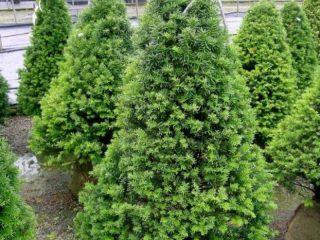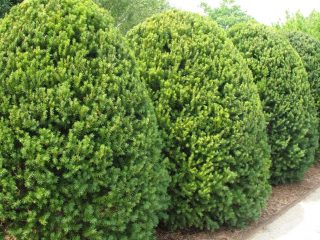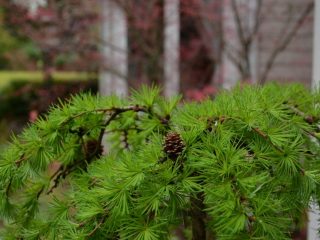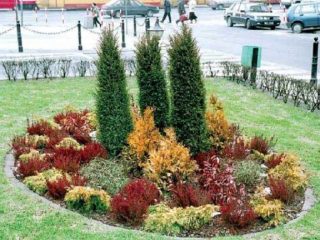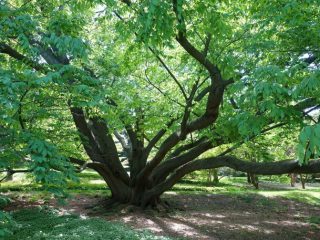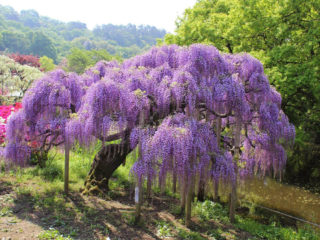Content
Summer cottages are often decorated with coniferous plants - small trees and shrubs. Among them you can find the medium yew, a hybrid that has gained fame among designers due to the decorative structure of the crown.
Description of medium yew with photo
The culture was obtained at the beginning of the last century as a result of crossing yew and pointed yew. The birthplace of the middle species is the USA. A characteristic feature of the culture is the elongated shape of the crown. It is emphasized by olive-green needles, which turn red with the arrival of cold weather.
Fruit formation occurs annually. Unlike other conifers, the fruits of the shrub do not look like cones in the usual way. They look more like berries. By the way, they also contain a pericarp inside, which protects the seeds.

Berries ripen in August or early September
The average yew species gets along well in shade and partial shade, has innate resistance to drought and cold - the species can be grown in different regions.
The best varieties
Currently, more than 30 varieties of this yew are known. The following varieties have become widespread in Russia:
Yew medium Wojtek
Ephedra has a unique pyramidal shape, which is perfectly suitable for planting a hedge. Other evergreens, as well as soft flowers, look great next to Wojtek.

Yew Wojtek is covered with dark needles with a vein in the central part
Yew average Densiformis
This variety is dwarf. The annual growth is about 10 cm, which is quite a lot. True, at one point the bush stops growing. Young needles have a light green color with a brown tint. The needles are always sharper in the upper part.
Yew densiformis is cultivated in Germany and France. Sometimes it can be found in the East. The plant combines with rocky landscapes.

The ephedra can be trimmed, and once a year it can be transplanted to a new place
Yew medium Farmen
The bush hybrid has a lush crown. Despite this, it is very compact and fits even in small areas. Designers recommend growing yew medium Farmen as a hedge.

Kazio variety tolerates formative pruning well
Medium yew Kazio
A fast-growing shrub with strong needles, Casio has a well-developed immune system and can be grown in any region. At 20 years old, the height of the conifer is 140-150 cm, the width of the crown is 70-80 cm. For a small bush, the average yew has long 5-centimeter needles.
Yew medium David (David)
The large David shrub grows up to 2.4 m in height. It has a greenish-yellow crown that holds color for a long time when planted in a sunny location.When grown in the shade, the needles are predominantly green. From the description of the middle yew, it turns out that David is a shade-tolerant crop and feels great in this environment.

The shrub has average frost resistance; landscape designers use it to create phytosculptures
Advantages and disadvantages
Medium yew is a species that can be grown in almost any region of Russia. This is its versatility.

The main advantage is the ability to plant shrubs in a substrate of any composition
Pros:
- undemanding;
- neat crown;
- annual formation of red fruits;
- winter hardiness.
Minuses:
- Most varieties grow worse in the sun than in the shade.
Landing rules
Experts recommend not to neglect planting standards, despite the unpretentiousness of the medium yew. The preferred location would be an area with medium loamy soil. To prepare it yourself, use loam, wood ash and humus.
When choosing a location, they give preference to closed areas - with moderate lighting and walls that protect the middle yew from drafts.
The hole should be deep enough to accommodate the roots. The average depth is 50 cm. If the plant is planted as a hedge, dig a trench. A spacing of 100-150 cm is maintained between seedlings. The bottom of the planting hole must be enriched with a drainage layer and fertilizer.
The root collar is left flush with the ground surface. After planting, the conifer is watered and covered with mulch.
Care for medium yew
Medium yew does not tolerate waterlogging. Watering should be regular but moderate. It is important to consider weather conditions and soil dryness.Young seedlings are protected in winter, but adults can simply be mulched
Caring for this type of yew also involves carrying out treatments to prevent damage by diseases and pests.

Pruning is carried out as it grows, usually at 2-3 years
With proper care, the crop will become an indispensable part of the dacha landscape. Unpretentious, friendly with other plants, it will win the attention of both the gardener and guests.
Reproduction
Ephedra can be propagated in two ways - using seeds and cuttings. Vaccination is occasionally practiced, but the process is best left to professionals. Cuttings are the best option for beginners. Seeds do not guarantee that the shrub will inherit the characteristics of the parent, since the average yew is a hybrid.
Conclusion
Medium yew is a crop obtained by Western breeders at the beginning of the last century and has not yet lost its popularity. The secret of its success is its unpretentiousness and decorative crown. Most varieties tolerate shearing easily, so the owner can create a sculpture of any shape.

